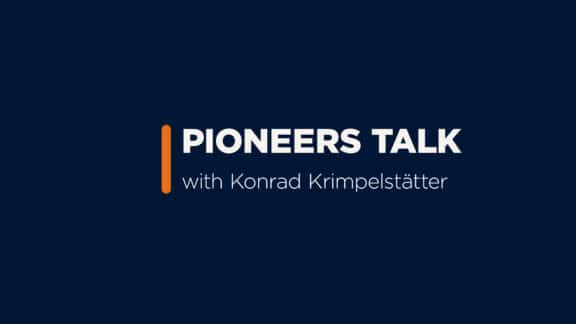Introducing “crafted scrap”—how steel producers can increase scrap use, decrease CO2 emissions, and increase energy efficiency while consistently producing high-quality steel. Crafted scrap is the result of a meltshop-controlled scrap preparation system combining hardware and software solutions consisting of E&A and mechanical elements, allowing for the ideal scrap mix and setting the new standard for scrap sorting, cleaning, and preparation for steel producers.
In this presentation from the 2022 Sustainable Steel Strategies Summit with
Steel Times International, SICON and Primetals Technologies present their work to create a fully automated, digital scrap yard.

Scrap and the Steel Industry:
Challenges and Opportunities
Cristiano Tercelli
My name is Cristiano Tercelli, and I work in the research and development of long products at Primetals Technologies Austria. I’m here today to talk about scrap and the steel industry. Will scrap become scarce, or will it be too low quality to be used for steelmaking?
Electric steelmaking is growing, and the appearance of “green steel” policies in most countries will change the way our steel is made in the future. Experts at Primetals Technologies expect more scrap to be available, but it will not be uniformly distributed across the globe. At the same time, the quality of scrap will worsen with time, while steel producers will demand cleaner scrap for their high-quality steel. Because of this, producers are motivated to invest in scrap management tools or equipment for scrap processing to improve the quality of the available scrap.
Why is scrap important? Today, 29% of steel globally is produced via electric steelmaking, most of which comes from scrap. The percentage varies from 90% in Asia and China to 45% in Europe and 65% in North America. As previously mentioned, more scrap will be available in the future, but not everywhere. Most of the increase will be in Asia and China, where steel used for infrastructure for the past 20 to 30 years will enter the market as scrap. At the same time, while scrap availability will increase there, it will remain practically constant or show limited growth in other areas of the world. Now the question is, what impact will this have? An increase in electric steelmaking will likely consume this excess of scrap. So, the increased amount of available scrap in Asia and China will most likely be used domestically. And the rest of the world will have to rely on the delivery of scrap, which is increasing only slowly.
On top of this, an increase in European electric steelmaking is an effect of “green steel” policies, with electric steelmaking reaching 60 percent of total European steel production by 2050. Most of the additional electric arc furnaces (EAFs) will be high-end furnaces, primarily melting DRI and other virgin materials. Still, they can melt scrap and will melt scrap to a certain extent if economic conditions are favorable. So, the question is, will there be more pressure on the market for prime scrap in the E.U. as the former integrated mills look for prime scrap to purchase? Will additional imports cover the increased demand? Or will Europe have to process the scrap currently bound for export internally and melt domestically? These are the questions.
Already in the U.S.A., increased EAF capacity is already putting pressure on the market for prime scrap. As a reaction, the first vertical integration of recyclers into the steelmaking groups as the latter react to the changing market conditions.
The next challenge is scrap quality. Clean steel needs clean scrap. However, successive recycling worsens scrap quality progressively. By 2050, in the absence of countermeasures, the percentage of copper in shredded scrap will be excessive for even the most straightforward steel applications. Again, we already see this in the U.S.A., where scrap shredders are already starting to equip themselves with scrap cleaning technologies. And we expect a broader trend toward applying scrap cleaning technologies in steelmaking.
After covering the big picture, let’s quickly look at the daily challenges of electric steelmaking—i.e., what do steel producers need and what is available today? Producers need high-quality scrap at a consistent quality level. Today, supply and demand and market price determine scrap quality. Steel producers need reliable and accurate quality control of scrap entering their premises. Today, quality control is mainly done with small scrap samples and visual checking of the scrap itself. So, there are discrepancies between the needs of the producers today and the reality of scrap supplies.
So, when these challenges resonate on the market, technology providers start to work on possible solutions and innovate. Specialists at Primetals Technologies believe the answer is two-fold. On the one hand, a quality improvement of scrap—i.e., scrap processing, cleaning, and sorting—and, on the other hand, integration of automation and sensors to achieve the comprehensive tracking of scrap in the meltshop up to the melting unit.

Mechanical Scrap Handling
Heiner Guschall
My name is Heiner Guschall. I am the founder and CEO of SICON. We are a company located in Germany and a cooperation partner with Primetals Technologies. We focus on supplying solutions for the refining and processing of scrap for the steel and scrap metal industries.
Today, I am talking about scrap handling and scrap cleaning solutions. We have two key systems: the HMS Cleaning Advanced for the cleaning and refining of sheared scrap and ScrapTuning used for shredded scrap. Three different designs are available for HMS Cleaning: a mobile system that can process up to 80 tons per hour, a basic system, and an advanced system that can process up to 300 tons per hour. ScrapTuning is used either offline for refining externally supplied shredded scrap or in combination with a shredding plant. It includes several different machines, from additional innovative magnet separation and air sifting to online scanning and automated sorting to achieve the goal of clean, shredded scrap. Regarding scrap cleaning, our philosophy is that steelmaking starts in the scrap yard.
Both systems have significant benefits for the steel producer. The HMS Cleaning Advanced is designed to clean the available quantities of HMS 1 and 2, which typically have a high level of impurities. Via the HMS Cleaning Advanced, we reduce impurities by more than 99%. The system includes optical and chemical sorting, including the EcoScan online, and by doing this, we increase the ferrous content from typical rates of 88 to 90 percent to over 94 percent. The ultimate goal is that we supply sheared scrap with chemical analysis according to the demands set by the meltshop.
ScrapTuning refines shredded scrap and can remove all free and chemically bound copper. We easily achieve copper levels in the range of 0.15 to 0.18 percent, compared to today’s practices without refining, where the copper content ranges from 0.35 up to 0.5 percent. Furthermore, we can remove all other unwanted tramp elements, meaning nickel, chromium impurities, or molybdenum can be detected and separated. That means we can supply to the meltshop a cleaned, shredded scrap with chemical analysis according to the meltshop. Cleaned, sorted, and analyzed scrap means the chemistry is known in advance so that the meltshop can base its recipe on actual data.
In the video below, you’ll see the HMS Cleaning Advanced in operation. It shows the feeding of HMS and its proper distribution on the first cleaning unit, a screen, where the material is moved, turned, and accelerated, followed by magnetic separation. The output of the HMS Cleaning Advanced is the cleaned and sorted HMS as well as impurities which previously could make up 10 to 12 percent of the feedstock. When you see the number of separated impurities, you realize that this is the material the meltshop would not like to have in the electric arc furnace. Furthermore, by integrating additional technology, such as the scrap monitor plus EcoScan Online, we can remove other compounds and continuously analyze the chemistry.
This video (below) shows the output of the ScrapTuning refining process. Here, you see shredded scrap, removed of any free copper with a documented chemical composition, so the steel producer does not have to concern themselves with fluctuations in quality.

Crafted Scrap as an Integral Part of Steelmaking
Andreas Melcher
My name is Andreas Melcher. I am the product manager for scrap yard automation at Primetals technologies in Linz, Austria. Today, I will talk about crafted scrap as an integral part of steel production.
So, let me first explain what is “crafted scrap.” Crafted scrap is the result a meltshop-controlled scrap preparation system combining hardware and software solutions, consisting of electrical, automation, and mechanical elements, to feed steel production assets with the most suitable scrap mix at minimum costs.
The process optimization system from Primetals Technologies is at the very heart of the system. The system receives data from a production planning system: the production plan, steel grade, and sequences. It receives data from the metallurgical database—i.e., recipes to produce specific steel grades. It draws data from the scrap yard warehouse-management system about what kind of scrap and what amounts are available for steel production. Based on this information, the system calculates production rules and set points to produce steel. And it can calculate processing instructions for the required scrap, including cutting, pre-shredding, shredding, cleaning, chemical analysis, and bailing. And following scrap processing, the stock will automatically be updated through the scrap yard warehouse-management system.
So let us look closely at the scrap yard automation solutions for a fully automated scrap yard. Various electric and automation elements start with the software simulation of the charging material flow and verify that enough scrap can be conveyed and prepared for steel production. There are various tools to monitor, analyze, and determine the chemical composition of the scrap, the scrap class, and identify unwanted and hazardous substances within the scrap mix. There are tools to determine the amount of available scrap in the scrap yard and assist with automatic delivery. There are tools to support the automatic loading of scrap and a scrap mover—i.e., an autonomous scrap transport system using batteries.
Combining all those components depending on your scrap yard layout can provide the correct scrap mix for your melting unit at minimum cost. Cost is kept low from the incoming inspection to verify the conformity of the delivered scrap with the order specification through scrap processing on site, which can help to reduce the residual materials and tramp elements. The scrap yard management system consists of stock monitoring and automation-supported crane operations. Scrap is loaded via cranes or conveyor belts and monitored to check quantity and quality through the meltshop. Finally, producers receive the perfect scrap mix at the melting unit.
The video material below shows the functions of such a system in operation. First, you can see the scrap tracker tracking each batch of scrap lifted from the scrap yard to a basket destined for the electric arc furnace. The data generated here is stored and used to verify the composition of the loaded scrap, so the actual values satisfy the scrap recipe. The system, of course, is suitable for loading electric arc furnace baskets or basic oxygen furnace chutes. The system uses the images generated by a video camera, which are fed to an algorithm. The algorithm determines the class of scrap that the crane lifts. The data is then compared with the scrap recipe and the actual values coming from the weighing system.
The system then tracks the transport of the scrap from the scrap yard to the melting unit. Tracking ensures that the loaded scrap meets the requirements according to the scrap recipe and will be charged to the correct melting unit. So, you can see the system in operation below, scanning a scrap chute on its way to a converter. The algorithm will evaluate the image, first showing the horizontal layering of the scrap within the chute, followed by the quality and the percentage of the scrap inside the chute.
In summary, with Primetals Technologies and SICON Smart Scrap Yard Solutions, you can check and verify the supply capacity of your scrap yard and process the most cost-effective scrap mix for your melting units. These systems improve your scrap quality to the standard of crafted scrap, enable quality tracking of your scrap load, keep your tapping analysis within the permissible limits, increase the yield, reduce energy consumption, and save CO2.
Cristiano Tercelli, Head of Technology and Innovation
Cristiano Tercelli is the Head of Technology and Innovation at Primetals Technologies. With twenty-five years of experience in the steel industry, Tercelli has planned, sold, commissioned, and transformed innovative steelmaking equipment. Currently, he is responsible for developing new products in electric steelmaking and long rolling at Primetals Technologies. His goal is to support the production of high-quality steel with the best available technologies.
Heiner Guschall, CEO SICON Germany
Heiner Guschall is the CEO and founder of SICON Germany and is responsible for everything from sales to research and development and holds numerous patented processes. SICON focuses on developing and implementing customized solutions for the processing and cleaning ferrous and non-ferrous metals and the resulting residual materials and supplies individual machines and complete and customized plants. With EcoScan® Online and LaserSort, SICON has introduced groundbreaking innovations for scrap processing and metal separation.
Andreas Melcher, Product Lifecycle Manager – Scrap Yard Automation
With over 30 years of professional experience in electrics and automation in metallurgical plant construction, Andreas Melcher is part of product lifecycle management for scrap yard automation at Primetals Technologies. His collective experience in plant automation includes hard- and software engineering, commissioning, technical assistance, project management, sales, hardware and software engineering, and business development and leadership in iron and steelmaking and continuous casting.
*The presentation transcripts have been edited for readability.


